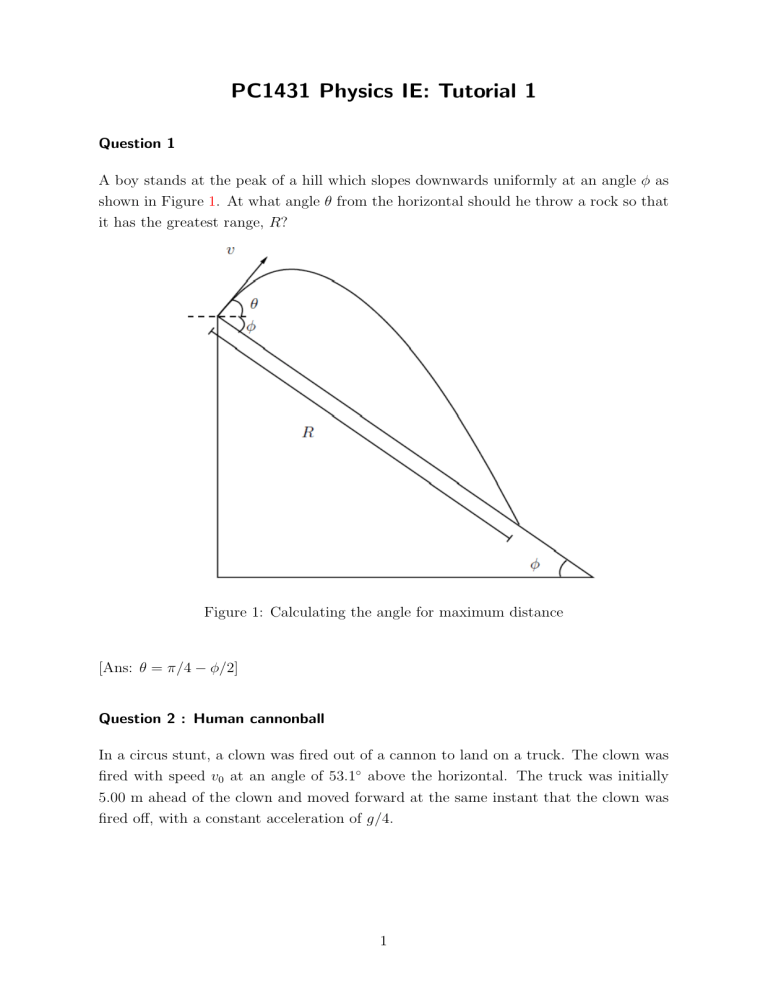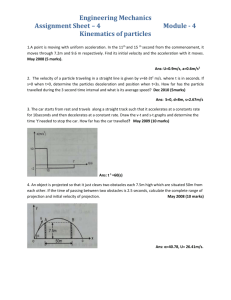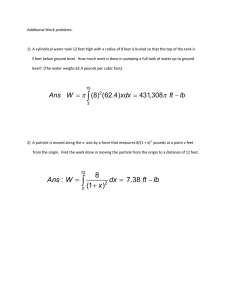
PC1431 Physics IE: Tutorial 1
Question 1
A boy stands at the peak of a hill which slopes downwards uniformly at an angle φ as shown in Figure
θ from the horizontal should he throw a rock so that it has the greatest range, R ?
Figure 1: Calculating the angle for maximum distance
[Ans: θ = π/ 4 − φ/ 2]
Question 2 : Human cannonball
In a circus stunt, a clown was fired out of a cannon to land on a truck. The clown was fired with speed v
0 at an angle of 53 .
1
◦ above the horizontal. The truck was initially
5.00 m ahead of the clown and moved forward at the same instant that the clown was fired off, with a constant acceleration of g/ 4.
1
Figure 2: The Human Cannonball
You may assume that the clown landed at the same level from which he was fired.
Also the truck starts from rest at the moment the clown was fired. At what value of v
0 would the stunt be successful? [Ans: 8 .
75 m / s]
Question 3
A car moving at 18 .
1 ms
− 1 enters a curve that describes a quarter turn of radius 120 m from A to B as shown in Figure
Figure 3: Turning a corner
The driver gently applies the brakes, slowing the car down at a constant rate of
0 .
65 ms
− 2 . Just before emerging from the turn at B , what is the angle between the acceleration vector and the direction of motion?
[Ans: 133
◦
]
2
Question 4
A small boat is headed for a harbour 32 km north-west of its current position when it is suddenly engulfed in a heavy fog. The captain maintains a compass bearing of north-west and a speed of 10 km/hr relative to the water. Three hours later the fog lifts and the captain notes that he is now exactly 4.0 km south of the harbour. Taking
ˆ to be directed along east and ˆ to be directed north, what is the velocity ~ of the current during those three hours? (You may assume that ~ is a constant.)
[Ans: ~ = − (0 .
47 km / hr) ˆ − (0 .
86 km / hr) ˆ ]
Question 5 : Cycloid
A particle is moving in 2 dimensions with velocity vector
~ ( t ) = rω h
(1 − cos( ωt ))ˆ − sin( ωt )ˆ i
, (1) where r is a constant, and ω = p g r is also a constant. The particle is initially at the origin, i.e. (0 , 0), and is traveling towards a point ( rπ, − 2 r ). Find the time traveled by the particle to reach the final position. [Ans: t
1
= π q r g
]
Suppose that another particle is moving in a straight line (initially at rest) with a constant acceleration a =
2 g
√
π 2 + 4 from the origin to the same point ( rπ, − 2 r ).
Calculate the time taken for this particle to reach the final position. Comparing the two results, what do you observe? [Ans: t
2
= π q r g q
1 +
π
4
2
]
Question 6 (for practice)
A particle has a position vector given by:
~ ( t ) = 3 .
0 t
2 ˆ
+ (4 .
0 t
3
− 5 .
0 t
4 where ~ is in meters and t is in seconds. Find the average velocity and average acceleration from t = 2 .
0 s to t = 4 .
0 s. [Ans: ~ avg
= 18ˆ − 488ˆ m/s and ~a avg
= 6 .
i − 488ˆ m/s 2 ]
Question 7 (for practice)
The speed of a particle moving in a circle 2.0 m in radius increases at the constant rate of 4 .
4 m / s
2
. At the instant when the magnitude of the total acceleration is 6 .
0 m / s
2
, what is the speed of the particle?
[Ans: 2 .
9 m / s]
3


